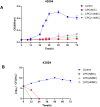In vitro anti-Helicobacter pylori activity and antivirulence activity of cetylpyridinium chloride
- PMID: 38603679
- PMCID: PMC11008818
- DOI: 10.1371/journal.pone.0300696
In vitro anti-Helicobacter pylori activity and antivirulence activity of cetylpyridinium chloride
Abstract
The primary treatment method for eradicating Helicobacter pylori (H. pylori) infection involves the use of antibiotic-based therapies. Due to the growing antibiotic resistance of H. pylori, there has been a surge of interest in exploring alternative therapies. Cetylpyridinium chloride (CPC) is a water-soluble and nonvolatile quaternary ammonium compound with exceptional broad-spectrum antibacterial properties. To date, there is no documented or described specific antibacterial action of CPC against H. pylori. Therefore, this study aimed to explore the in vitro activity of CPC against H. pylori and its potential antibacterial mechanism. CPC exhibited significant in vitro activity against H. pylori, with MICs ranging from 0.16 to 0.62 μg/mL and MBCs ranging from 0.31 to 1.24 μg/mL. CPC could result in morphological and physiological modifications in H. pylori, leading to the suppression of virulence and adherence genes expression, including flaA, flaB, babB, alpA, alpB, ureE, and ureF, and inhibition of urease activity. CPC has demonstrated in vitro activity against H. pylori by inhibiting its growth, inducing damage to the bacterial structure, reducing virulence and adherence factors expression, and inhibiting urease activity.
Copyright: © 2024 Xun et al. This is an open access article distributed under the terms of the Creative Commons Attribution License, which permits unrestricted use, distribution, and reproduction in any medium, provided the original author and source are credited.
Conflict of interest statement
The authors have declared that no competing interests exist.
Figures




Similar articles
-
In vitro anti-Helicobacter pylori activity and the underlining mechanism of an empirical herbal formula - Hezi Qingyou.Front Microbiol. 2024 Feb 19;15:1355460. doi: 10.3389/fmicb.2024.1355460. eCollection 2024. Front Microbiol. 2024. PMID: 38440143 Free PMC article.
-
In-vitro anti-Helicobacter pylori activity and preliminary mechanism of action of Canarium album Raeusch. fruit extracts.J Ethnopharmacol. 2022 Jan 30;283:114578. doi: 10.1016/j.jep.2021.114578. Epub 2021 Aug 28. J Ethnopharmacol. 2022. PMID: 34464702
-
A potential anti-Helicobacter pylori strategy: Exploring the antibacterial mechanism of organic acids in sea buckthorn (Hippophae rhamnoides L.).Microbiol Res. 2025 Jul;296:128133. doi: 10.1016/j.micres.2025.128133. Epub 2025 Mar 4. Microbiol Res. 2025. PMID: 40073720
-
Medicinal plant activity on Helicobacter pylori related diseases.World J Gastroenterol. 2014 Aug 14;20(30):10368-82. doi: 10.3748/wjg.v20.i30.10368. World J Gastroenterol. 2014. PMID: 25132753 Free PMC article. Review.
-
Mechanisms of Helicobacter pylori infection: bacterial factors.Curr Top Microbiol Immunol. 1999;241:155-80. doi: 10.1007/978-3-642-60013-5_9. Curr Top Microbiol Immunol. 1999. PMID: 10087661 Review.
References
-
- Meurer LN, Bower DJ. Management of Helicobacter pylori infection. American family physician. 2002;65(7):1327–37. - PubMed
-
- Al-Rajhi AMH, Qanash H, Bazaid AS, Binsaleh NK, Abdelghany TM. Pharmacological Evaluation of Acacia nilotica Flower Extract against Helicobacter pylori and Human Hepatocellular Carcinoma In Vitro and In Silico. J Funct Biomater. 2023;14(4). Epub 2023/04/27. doi: 10.3390/jfb14040237 . - DOI - PMC - PubMed
MeSH terms
Substances
LinkOut - more resources
Full Text Sources
Medical

